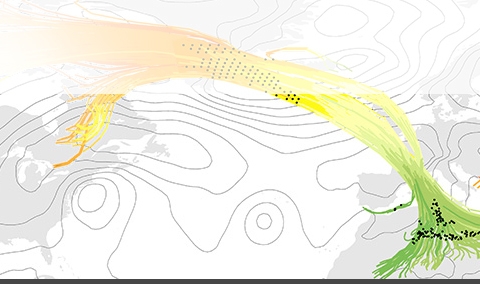The data shown comes from two sources:
1. Weizmann weather station
The Weizmann weather station (Location: 31.909°N, 34.820°E, Elevation: 57 m above sea level) became operational on 18 December 2022. This station is part of a network of weather stations in Israel, maintained by EnviroManager ltd.
Let’s have a look at the measured variables and instruments:
- Temperature - measured at 2 m above ground level [°C]
- Relative humidity - measured at 2 m above ground level [%]
- Wind speed - measured at 10 m above ground level [m/s].
- Wind direction (also shown on the map) - from which the wind is coming at 10-m height above ground level, i.e:
0°- Northerly wind flowing from north to south;
90°- Easterly wind, and so on.
- Wind gust - The 1-second maximum value of the wind speed during the last 10 minutes [m/s].
- Rain rate (intensity) - the accumulated rain [mm] for the last 10 minutes, converted to units of mm/hour.
- Daily accumulated rain - calculated since the beginning of the day (00:00 local time) [mm].
- Radiation - the incident short-wave radiation [W/m2]
We also show the accumulated rain since the beginning of the season (1 August). The annual mean is based on Beit Dagan, a nearby station, since there is not yet a long enough record for the Weizmann station.

Figure 1: Weizmann weather station.

Figure 2: The sensors at the Weizmann weather station: (A) The radiation sensor (Hukseflux SR20-T1l); (B) Temperature and relative humidity sensors (Vaisala’s HMP155); (C) Rain gauge (D) Ultrasonic wind sensor. Both the rain gauge and the ultrasonic wind were manufactured by Clima Thies. The station’s data logger is a Campbell scientific product.
2. Micro Rain Radar (MRR)
The micro rain radar, a product of METEK, is located on the top of the Sussman building (The Department of Earth and Planetary Sciences), ~ 1 km south-west of the weather station and became operational on 19 February 2023. The MRR can measure reflectivity, rain rate and other related variables. The MRR is not a conventional weather radar. It is smaller in size and its wavelength is shorter (1.23 cm, “K band”) compared to the conventional X, C, or S-band (3, 5 and 10 cm wavelength, respectively) weather radars. Uniquely, this radar is looking up and it measures continuously. It has 32 range heights and its spatial resolution is up to 100 m height. In contrast to conventional weather radars, which receive the backscattered radiation based on Rayleigh scattering theory (when the transmitted wavelength is much larger than the particle size), the MRR wavelength is much smaller, so it can only detect very small particles, according to Rayleigh scattering. To avoid this limitation, its principle is also based on Mie scattering approximation.
The software calculates rain rates for each of the 32 elevations.
In order to extract the current rain rate from radar, the instantaneous (last 1-min average) rain rate from the relevant height (100-300 m above the radar) is calculated and converted to units of mm/hour.
The estimated daily rain from radar, is calculated by summing the rain rate for each time step (1 minute) throughout the entire calendar day (local time).
In addition, a graph showing the rain rate at each height for the past 24 hours is presented.

Figure 3: The micro rain radar, located on the top of the Sussman building (The Department of Earth and Planetary Sciences) at Weizmann Institute of Science.


